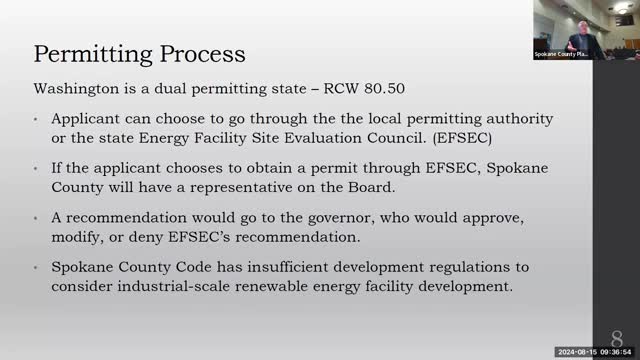Spokane County tackles wind energy regulations amid rising concerns
August 20, 2024 | Spokane County, Washington
This article was created by AI summarizing key points discussed. AI makes mistakes, so for full details and context, please refer to the video of the full meeting. Please report any errors so we can fix them. Report an error »

In a recent government meeting, discussions centered around proposed zoning regulations for wind energy projects in Spokane County, highlighting the need for local governance in the face of state preemption. The FSEC committee, which oversees energy projects, allows applicants to bypass local regulations, prompting concerns about Spokane County's ability to influence development that could significantly impact the community.
The proposed code aims to establish clear guidelines that reflect Spokane's public policy values, ensuring that local interests are represented even when projects are submitted directly to the state. Key topics included public safety, environmental considerations, and the technical specifications of wind turbines, which have seen substantial increases in height and energy generation capacity over the years.
The meeting revealed that the average height of land-based wind turbines has escalated from under 90 feet in the late 1990s to nearly 300 feet today, with offshore turbines reaching up to 500 feet. This growth necessitates larger setbacks from occupied buildings to mitigate safety risks and operational impacts. Recommendations for setbacks ranged from 1,000 to 2,500 feet, depending on the turbine height and rotor diameter.
Additional concerns addressed included visual and noise impacts, with suggestions for neutral colors on turbines and measures to minimize sound disturbances. The phenomenon of \"shadow flicker,\" caused by sunlight passing through turbine rotors, was also discussed, with proposed strategies to limit its effects on nearby residences.
The meeting concluded with a commitment to draft a zoning text amendment, which is expected to be presented for consideration on August 29. The urgency of these regulations stems from ongoing discussions with national energy companies interested in developing projects in the area, emphasizing the need for Spokane County to establish a regulatory framework that balances renewable energy development with community interests.
The proposed code aims to establish clear guidelines that reflect Spokane's public policy values, ensuring that local interests are represented even when projects are submitted directly to the state. Key topics included public safety, environmental considerations, and the technical specifications of wind turbines, which have seen substantial increases in height and energy generation capacity over the years.
The meeting revealed that the average height of land-based wind turbines has escalated from under 90 feet in the late 1990s to nearly 300 feet today, with offshore turbines reaching up to 500 feet. This growth necessitates larger setbacks from occupied buildings to mitigate safety risks and operational impacts. Recommendations for setbacks ranged from 1,000 to 2,500 feet, depending on the turbine height and rotor diameter.
Additional concerns addressed included visual and noise impacts, with suggestions for neutral colors on turbines and measures to minimize sound disturbances. The phenomenon of \"shadow flicker,\" caused by sunlight passing through turbine rotors, was also discussed, with proposed strategies to limit its effects on nearby residences.
The meeting concluded with a commitment to draft a zoning text amendment, which is expected to be presented for consideration on August 29. The urgency of these regulations stems from ongoing discussions with national energy companies interested in developing projects in the area, emphasizing the need for Spokane County to establish a regulatory framework that balances renewable energy development with community interests.
View full meeting
This article is based on a recent meeting—watch the full video and explore the complete transcript for deeper insights into the discussion.
View full meeting
